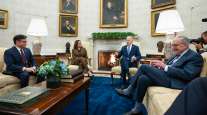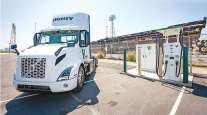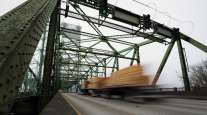Obama Expected to Pressure Congress to Increase Spending on Infrastructure
This story appears in the April 8 print edition of Transport Topics.
President Obama is expected to unveil a budget April 10 that contains billions of dollars in new infrastructure funding as he steps up pressure on Congress to invest in the nation’s roads, bridges, ports and public transit.
“We can’t afford for Washington politics to stand in the way of America’s progress,” Obama said during a March 29 visit to the Port of Miami, where he previewed his upcoming spending plan.
Among the spending items Obama will seek is $10 billion for an infrastructure bank, $4 billion for grant and bond programs created by the 2009 economic stimulus bill, and partnerships with private investors, including those from foreign countries, to help pay for projects.
Companies considering locating in the United States will not do so unless the country steps up infrastructure investment, Obama said in Miami, where a port tunnel is being built with the help of private capital.
“Are you going to set up shop in a country that’s got raggedy roads, runways that are potholed and backed-up supply chains?” he asked
The upcoming budget, the Miami speech and Obama’s recent $50 billion “Fix-It-First” proposal for roads, bridges and transit are part of his new emphasis on infrastructure, said Patrick Sabol, a senior researcher at the Brookings Institution who specializes in infrastructure investment.
“The White House has been doing a lot of outreach on this kind of stuff to a lot of stakeholders,” Sabol said, calling the outreach program an “end run” around Congress.
White House staffers are meeting with transportation and finance experts from Brookings and other groups and reaching out to governors and mayors in an attempt to build support for greater infrastructure spending, Sabol added.
“The administration is taking positive steps, thinking of infrastructure as an important issue that not only the U.S. needs from an economic standpoint to keep trucks on the road and people getting to jobs but also as a strong job creator,” Sabol said.
Not everyone, however, thinks the Obama administration is stepping up pressure or making progress on infrastructure investment.
“Stepping it up in my mind would be identifying a revenue source or a cut that is going to pay for it,” said Joshua Schank, president of the Eno Center for Transportation, another Washington think tank.
“Either of those things, that’s a huge step up, but just talking more about infrastructure investment, that hasn’t worked so far,” Schank said.
Sean O’Neill, director of congressional relations for the Associated General Contractors, also expressed skepticism that the White House was advancing a new or stronger strategy for infrastructure investment.
“I think if you look at the president’s proposal (and we’ll see what comes out in the budget ultimately), these aren’t a lot of new ideas,” said O’Neill.
The president has called several times for the creation of an infrastructure bank, the first time in early 2011 when he presented his 2012 budget, although at the time, he asked for only $5 billion for the bank.
“The Fix-It-First, the $50 billion, that’s the second or third time he’s offered that up,” O’Neill said. “That won’t go anywhere on the Hill.”
In the same 2012 budget proposal that included the infrastructure bank, Obama asked for $50 billion in what he called “up-front” money to spend on transportation projects that would foster job creation. The budget never was approved by Congress.
In his Miami speech, the president said that efforts to increase transportation investments, largely via the economic stimulus program to offset the recession, have paid a small dividend.
“Because of these efforts, when the American Society of [Civil] Engineers put out their 2013 report card on our national infrastructure, they gave it the best overall grade in 12 years,” Obama said.
“That’s the good news. The bad news is we went from a D to a D+,” he said, adding that the country still needs to address deferred maintenance issues, port development to keep up with trade, as well as “roads that are in disrepair, too many bridges that aren’t safe.”




